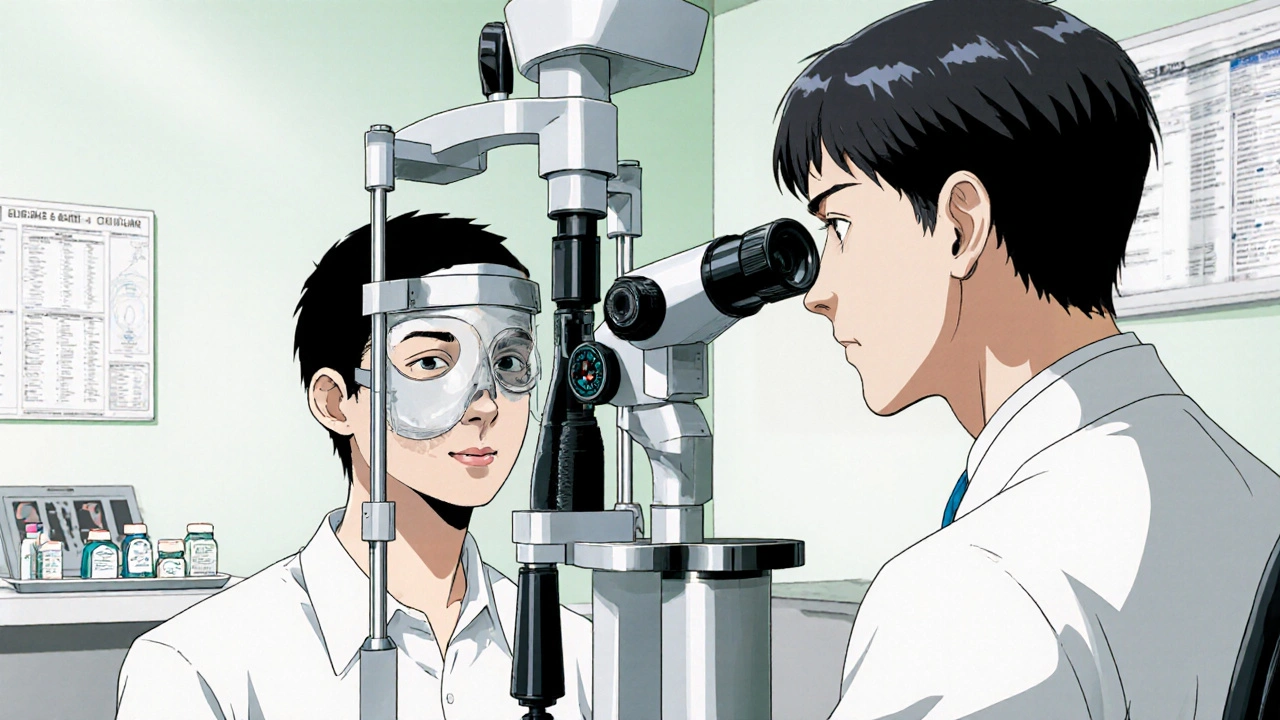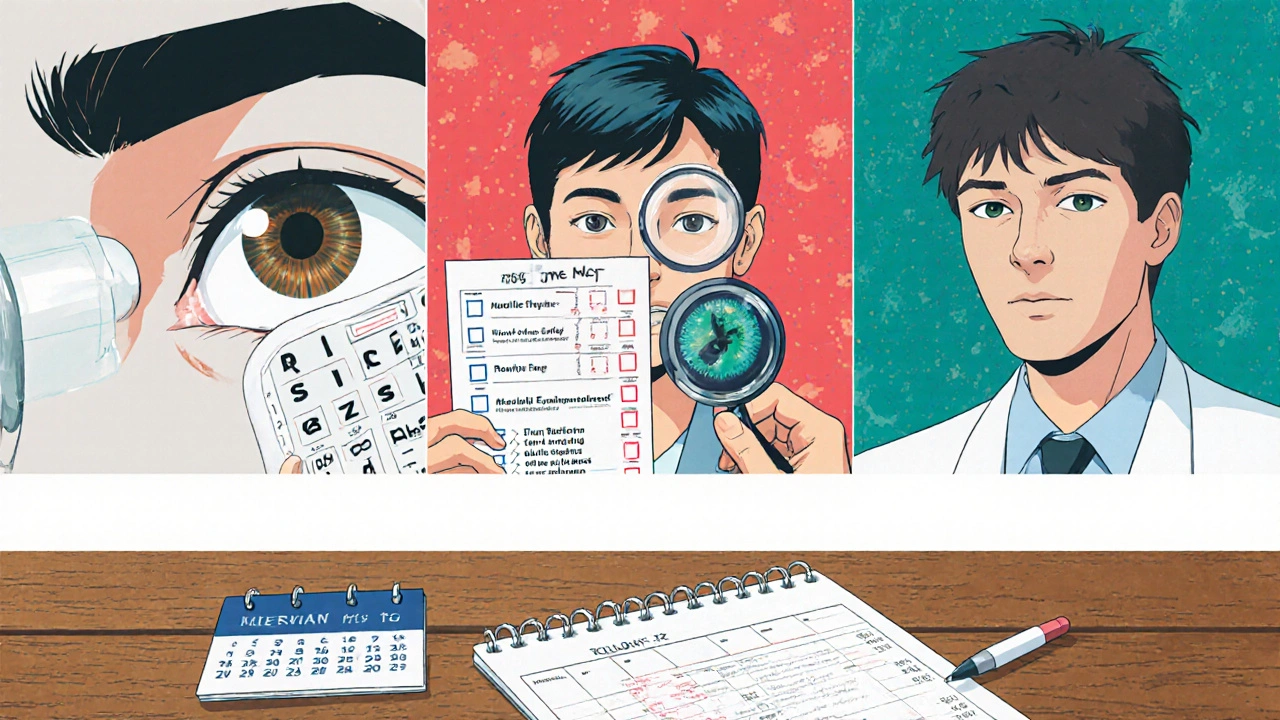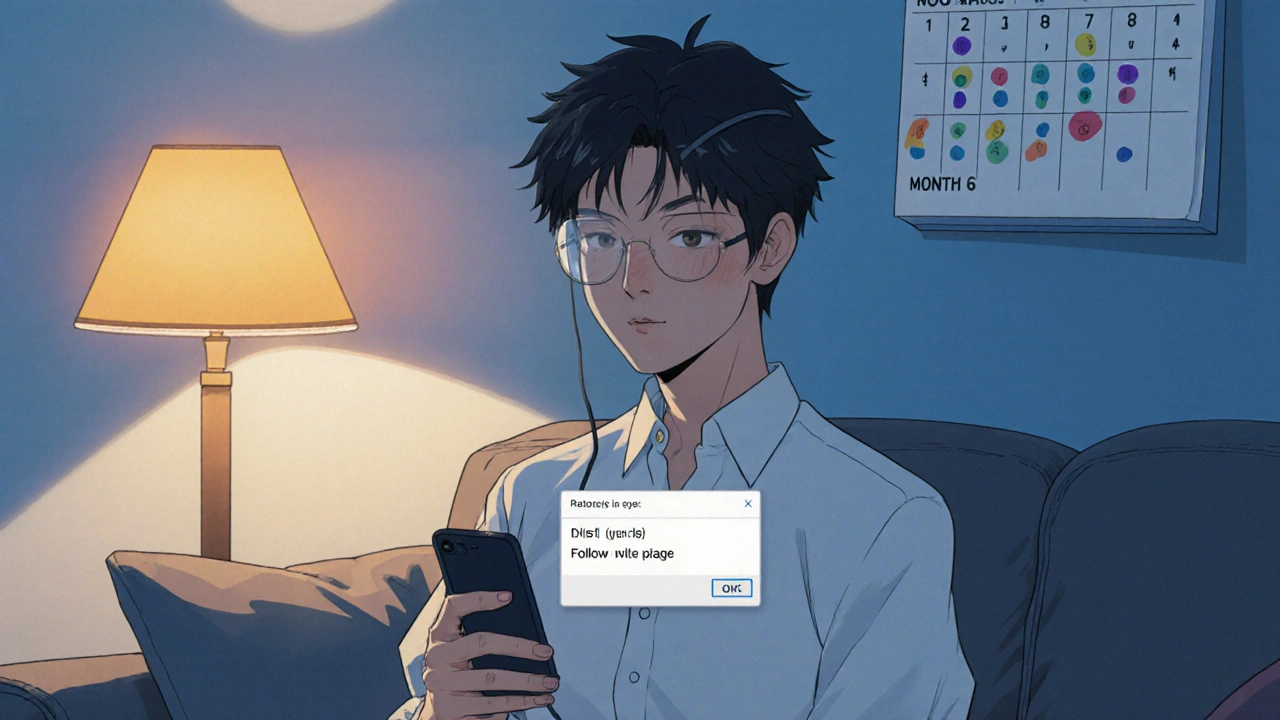Eye Surgery Follow-Up Tracker
Track Your Recovery Timeline
Enter your surgery details to see when your next follow-up appointments should be scheduled for optimal recovery.
When you leave the operating room after eye surgery, the real work often begins at home. A flash of relief can quickly turn into redness, pain, or blurry vision if inflammation spikes. The simple act of scheduling and attending follow‑up appointments can mean the difference between a smooth recovery and a setback that threatens vision.
Key Takeaways
- Follow‑up visits let ophthalmologists detect early signs of inflammation that patients may miss.
- Different surgeries have distinct follow‑up timelines; staying on schedule is essential.
- Patients should know what to expect during each exam and how to prepare.
- Using the right eye drops at the right time reduces complications and speeds healing.
- Missing appointments increases the risk of pressure spikes, scar formation, and permanent vision loss.
Postoperative ocular inflammation is the body's natural response to surgical trauma inside the eye. It manifests as redness, cells in the anterior chamber, and sometimes swelling of the cornea or retina. While some inflammation is expected, uncontrolled swelling can raise intraocular pressure, damage delicate structures, and cloud vision.
Understanding Post‑Surgical Eye Inflammation
Inflammation after eye procedures is driven by cytokines released when tissue is cut or cauterized. The most common signs include:
- Conjunctival hyperemia (red eye)
- Anterior chamber flare and cells, seen under a slit‑lamp
- Corneal edema causing hazy vision
- Increased intraocular pressure (IOP)
Untreated, these symptoms can evolve into cystoid macular edema, secondary glaucoma, or even permanent scar tissue.
Why Follow‑Up Appointments Matter
During a follow‑up, the Ophthalmologist performs a slit‑lamp examination, measures IOP, and checks the surgical site for leaks or infection. Early detection allows swift adjustment of medication-adding a steroid drop, reducing a nonsteroidal anti‑inflammatory drug (NSAID), or prescribing a pressure‑lowering agent.
Skipping or delaying visits lets inflammation run unchecked, which can lead to:
- Formation of synechiae (iris‑cornea adhesions)
- Persistent corneal edema that blurs vision for months
- Secondary cataract formation after posterior segment surgery

Typical Follow‑Up Schedules by Surgery Type
Not every eye operation follows the same calendar. Below is a quick reference most surgeons use:
| Procedure | Day 1 | Week 1 | Week 4 | Month 3 | Month 6 |
|---|---|---|---|---|---|
| Cataract surgery | Check IOP, ensure corneal clarity | Assess anterior chamber reaction, taper steroids | Confirm visual acuity, discontinue drops if stable | Screen for posterior capsular opacification | Final stability check |
| LASIK | Corneal flap position, basic epithelium health | Evaluate haze, adjust NSAID drops | Verify refractive stability | Long‑term visual quality | Rare complications review |
| Retinal detachment repair | Check for retinal re‑attachment, IOP | Monitor for proliferative vitreoretinopathy | Evaluate macular edema | Assess visual field | Confirm permanent re‑attachment |
What Clinicians Look For at Every Visit
Each appointment follows a repeatable checklist. Knowing it helps you understand why the doctor asks certain questions.
- Visual acuity test - Any drop in letters may hint at edema.
- Slit‑lamp biomicroscopy - Detects cells, flare, or corneal haze.
- Intraocular pressure measurement - Elevated IOP can be a steroid side‑effect.
- Fundus examination - Important after posterior segment work.
- Medication review - Ensures proper dosing and adherence.
How Patients Can Prepare for a Follow‑Up
Preparation is simple but often overlooked:
- Bring a written list of all eye drops, including brand and dosage.
- Note the exact time you applied your last drop before the exam.
- Write down any new symptoms: pain, flashes, or sudden vision loss.
- Carry a backup pair of glasses if you wear them.
Being organized lets the Ophthalmologist focus on the exam rather than gathering information.

Common Pitfalls and How to Avoid Them
Even diligent patients slip up. Here are the top three mistakes and the fix.
| Mistake | Consequence | Prevention |
|---|---|---|
| Missing the Day‑1 visit | Undetected pressure spikes or wound leaks | Set a reminder the night before surgery |
| Skipping steroid taper | Rebound inflammation, possible scarring | Follow the exact schedule your doctor provides |
| Using over‑the‑counter drops without approval | Interaction with prescribed meds, delayed healing | Ask the clinic before adding any product |
Checklist for Patients
Print this out and bring it to every appointment.
- Bring medication list and dosing schedule.
- Note time of last drop before exam.
- Record any new symptoms (pain, redness, flashes).
- Confirm next appointment date before leaving.
- Ask clarification questions about any prescribed changes.
FAQ
How soon after eye surgery should I expect the first follow‑up?
Most surgeons schedule a Day‑1 visit to check for wound integrity and intraocular pressure. Skipping it can miss early leaks or pressure spikes.
Can I skip steroid drops once my eye looks clear?
Never. Steroid tapering is a precise schedule. Stopping too early often triggers rebound inflammation.
What signs mean I need an emergency appointment?
Sudden vision loss, severe pain, flashing lights, or a rapid increase in redness-all require immediate evaluation.
Do all eye surgeries require the same follow‑up schedule?
No. Cataract extraction, LASIK, and retinal repairs each have unique timelines, as shown in the table above.
Will my insurance cover these follow‑up visits?
In most regions, postoperative visits are considered part of the surgical bundle and are covered. Verify with your provider.
Managing postoperative eye inflammation effectively starts with timely follow‑ups. By understanding what the doctor will check, preparing ahead, and keeping every appointment, you give your eyes the best chance to heal without lasting damage.

Joe Moore
October 18, 2025 AT 12:46Man, they don’t tell ya that these follow‑up visits are a cash‑grab by the big pharma. They want you to keep buying those pricey steroid drops forever, and they even schedule extra appointments just to keep the clinic full. Don’t trust the schedule they push, set your own reminder and call them later. I’m telling ya, the whole thing’s a set‑up.
Ayla Stewart
October 18, 2025 AT 15:16It's good to know that day‑1 checks can catch pressure spikes early, and that keeping a list of your drops helps the doctor focus on what matters.
Emma Williams
October 18, 2025 AT 17:29Sounds solid I’ll follow the schedule
Stephanie Zaragoza
October 18, 2025 AT 20:49Indeed, the postoperative regimen-if adhered to precisely-significantly reduces the risk of cystoid macular edema; consequently, patients should never, under any circumstances, deviate from the prescribed tapering schedule, regardless of how clear the eye may appear.
James Mali
October 18, 2025 AT 22:12Skipping appointments is like ignoring the inevitable entropy of healing 😐
Janet Morales
October 19, 2025 AT 01:16Oh, so you think a simple follow‑up is just bureaucratic fluff? Think again! The moment you skip that visit, you’re flirting with permanent scar tissue, and that’s not a metaphor-it’s a harsh reality that most patients refuse to face until it’s too late.
Tracy O'Keeffe
October 19, 2025 AT 03:12Honestly, the entire paradigm of scheduled postoperative surveillance is a vestigial relic, a pseudo‑clinical choreography masquerading as evidence‑based practice; one must interrogate the epistemic foundations of these regimented timelines before surrendering to the orthodoxy.
Matthew Miller
October 19, 2025 AT 06:49Hey, love the critical eye! But think of it this way-those check‑ups are like checkpoints in a video game, giving you power‑ups (the right meds) to beat the boss level of inflammation.
Norman Adams
October 19, 2025 AT 08:29Wow, turning eye surgery into a videogame, how original. Maybe next they'll hand out loot boxes for every drop you take.
Linda A
October 19, 2025 AT 12:39In the quiet moments after surgery, the eye becomes a microcosm of balance; the surgeon’s guidance and the patient’s diligence intersect, and only through disciplined follow‑ups does the fragile equilibrium resolve into clear vision.
Poornima Ganesan
October 19, 2025 AT 18:12Let me set the record straight: postoperative inflammation is not a vague inconvenience, it is a quantifiable cascade of cytokine activity that can be mathematically modeled.
The literature, from peer‑reviewed journals to clinical trial meta‑analyses, consistently shows that a missed Day‑1 visit increases the odds of pressure spikes by more than 30 %.
Yet patients, lulled by the false promise of 'quick recovery,' often dismiss these warnings.
Ignore the data at your own peril.
Moreover, the pharmacokinetics of topical steroids demand strict adherence to the taper schedule; deviating even by a single dose can create a rebound phenomenon that is, frankly, predictable.
If you think a single missed appointment is harmless, consider the downstream cost: additional surgeries, extended medication regimens, and irreversible visual loss.
The standard follow‑up table is not arbitrary; it reflects empirical findings across thousands of cases.
Skipping the week‑1 assessment eliminates the opportunity to catch early corneal edema before it becomes permanent haze.
The month‑3 check is especially critical for cataract patients at risk of posterior capsular opacification-an issue that can be mitigated with early intervention.
Furthermore, insurance coverage is contingent on documented compliance; missing appointments may void your benefits.
In short, the protocol exists for a reason, and treating it as optional is a reckless gamble.
I advise anyone reading this to mark every appointment in their calendar, set multiple reminders, and treat the follow‑up regimen with the same seriousness as the surgery itself.
Patients frequently report that the inconvenience of a short visit is negligible compared to the potential for permanent damage.
Clinical pathways have been optimized to detect subclinical inflammation long before symptoms appear.
By the time redness becomes obvious, the underlying cellular processes have already progressed.
Thus, proactive monitoring is not a luxury, it is a necessity.